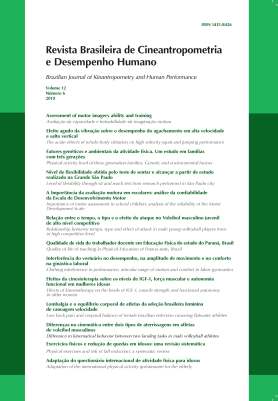Clothing interference in performance, articular range of motion and comfort in labor gymnastics
DOI:
https://doi.org/10.1590/1980-0037.2010v12n6p443Resumen
The objective of this descriptive case study was to analyze the interference of clothing with exercise performance, joint range of motion (ROM), and comfort during a session of labor gymnastics wearing a uniform (UNI) and specific exercise clothes (SEC). Twenty female workers (28.9±10.2 years) from a company in Florianópolis were studied. A photo camera, Wells bench, a questionnaire, and interview were used for data collection. The subjects were submitted to seven types of exercise wearing UNI and SEC: hip flexion, shoulder flexion, trunk flexion-hips and ankle angles, shoulder extension, modified trunk flexion-hips and ankle angles, horizontal shoulder adduction, and a sit-and-reach test. The results were analyzed using the paired t-test, chi-square test, and Fisher’s exact test (p?0.05). Seven women wearing UNI tended not to show the body, 17 removed some part of UNI, and 13 noted movement limitation. Discomfort was lower in the upper body part during hip flexion and horizontal shoulder adduction and in the lower part during shoulder flexion, extension and horizontal shoulder adduction. Lower ROM values were observed for subjects wearing UNI compared to those wearing SEC during hip flexion (p=0.017), shoulder flexion (p=0.0075), trunk flexion (hips and ankle angles), modified trunk flexion (ankle angles), and the sit-and-reach test (linear and angular values) (p<0.001). Trunk flexion performance (ankle angles) was better in the UNI condition (p=0.001), probably because the subjects were wearing shoes. In conclusion, clothing tends to interfere with ROM and comfort, but not with exercise performance.Publicado
2010-09-05
Número
Sección
Artigos Originais
Licencia

Direitos Autorais para artigos publicados nesta revista são do autor, com direitos de primeira publicação para a revista. Em virtude da aparecerem nesta revista de acesso público, os artigos são de uso gratuito, com atribuições próprias, em aplicações educacionais e não-comerciais, desde que seja dada a atribuição. Esta obra foi licenciada com uma Licença Creative Commons Atribuição 4.0 Internacional - CC BY


